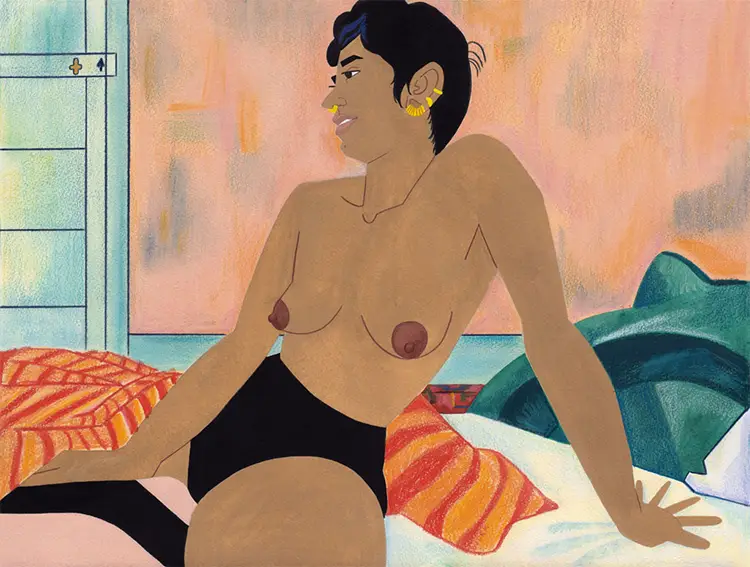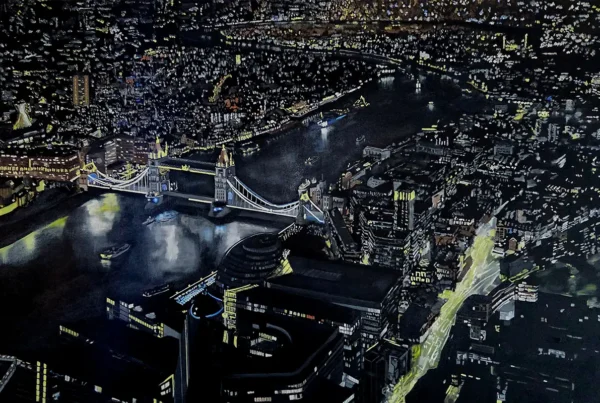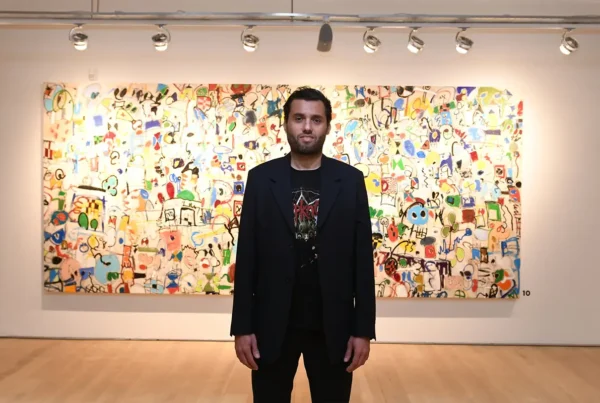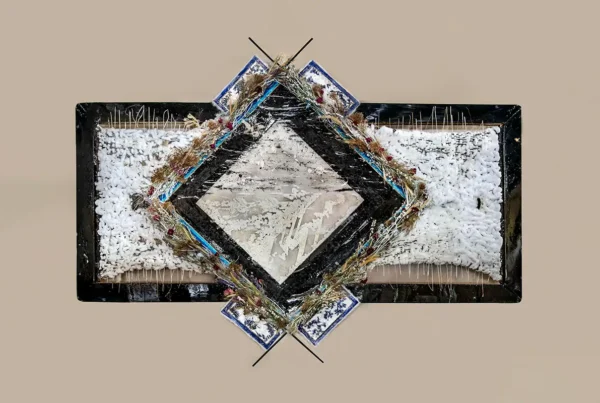“I offer my work as a shield, a shelter, a cup of tea, a warm blanket.”
Soft Power: The Quiet Magnetism of Daily Life
From the calm waters of the Pacific Northwest to the intimate corners of her Seattle home, Kelly Bjork’s work draws its vitality from the subtle moments that pass quietly, yet linger long after. Raised in Tacoma and now rooted in Seattle’s vibrant queer community, Bjork lives and creates within an environment that feeds both their spirit and their practice. Surrounded by towering trees and endless waterways, their daily life pulses with understated magic, providing the emotional scaffolding for their distinctive visual language. In the solitude of mourning their feline companion Heschke, who shared sixteen years of their life, Bjork continues to find inspiration through personal grief, transforming the ordinary into intimate portraits of memory and presence.
Art has always been Bjork’s means of survival, not merely expression. From the moment they could grasp a pencil, drawing became their anchor—a way to process the world and their place within it. While formal education in drawing and printmaking at Western Washington University refined their technical voice, it was a solo show in a local coffee shop in 2016 that truly shifted their trajectory. There, for the first time, they created work solely for themself, untethered by expectations. The authenticity of that body of work resonated, sparking a wave of opportunities in illustration and solidifying their belief in the emotional potency of genuine creation. Their path wasn’t mapped out—it emerged organically, rooted in an inner necessity to keep making, to stay grounded, and to remain sane through artistic engagement.
Rather than relying on spectacle, Bjork’s compositions gently invite viewers into carefully constructed scenes where connection, affection, and vulnerability unfold with quiet strength. Their creative vocabulary hinges on subtle visual devices: flattened perspectives, restrained textures, and carefully calibrated color palettes. While these techniques may initially appear deceptively simple, they serve as powerful conduits for deeper inquiry. The aesthetic accessibility of their work opens the door for viewers to absorb its more philosophical undercurrents. Their images often act as safe spaces—gentle refuges from a world that is anything but—and in that stillness, they make space for both introspection and resistance.
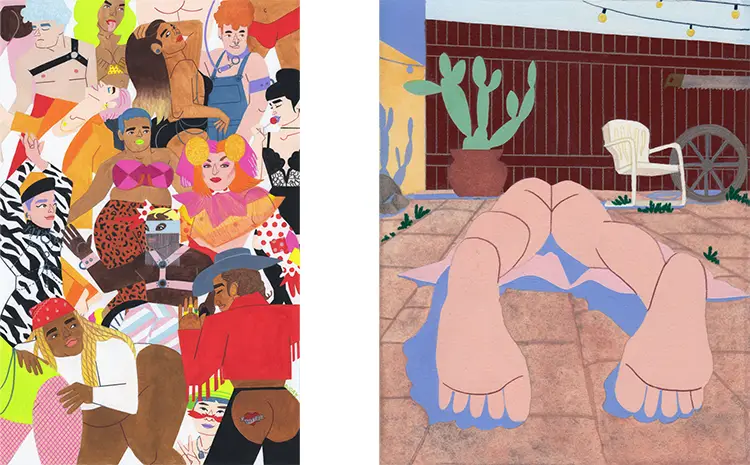
Kelly Bjork: Queer Joy as Defiance
In an era marked by renewed hostility toward LGBTQ+ identities, Kelly Bjork’s work refuses to be sidelined. Instead of meeting aggression with confrontation, their pieces offer sanctuary—spaces of warmth, affection, and unapologetic visibility. They identify themself as a queer artist making queer art, not as a declaration of defiance but as a continuation of a lineage. Their canvases do not shout; they hold, cradle, and console. By creating visual narratives that emphasize intimacy and connection, they affirm a truth too often dismissed: tenderness can be radical. Their art becomes both shield and invitation, pushing back against systemic violence through care, presence, and truth-telling.
Each composition functions as a gentle assertion of their and their community’s right to exist fully and joyfully. In an art landscape often dominated by spectacle and confrontation, Bjork’s approach is notably deliberate. Their characters exist in domestic spaces, not as escape, but as quiet battlegrounds of identity and belonging. They are brushing each other’s hair, resting on couches, or sharing moments of silence—acts that become revolutionary in their softness. Their art doesn’t look away from hardship; rather, it insists on holding joy in tandem with pain. It doesn’t simply ask viewers to witness—it asks them to feel.
A standout example of this emotional layering can be seen in their painting Emotional Oasis (Domestic Scene), which was inspired by David Hockney’s portrayal of intimate, everyday moments. In this piece, three figures occupy a bathroom: two are in the shower, with one brushing the other’s hair, while a third observes from a toilet seat. What makes this work particularly poignant is its backstory—Bjork invited three close friends to pose for the composition. That moment of collaboration wasn’t just part of their process; it was the very soul of the piece. To them, community is not just a source of support, but an essential component of creation. The painting, like much of their work, becomes a living archive of chosen family, mutual care, and trust.
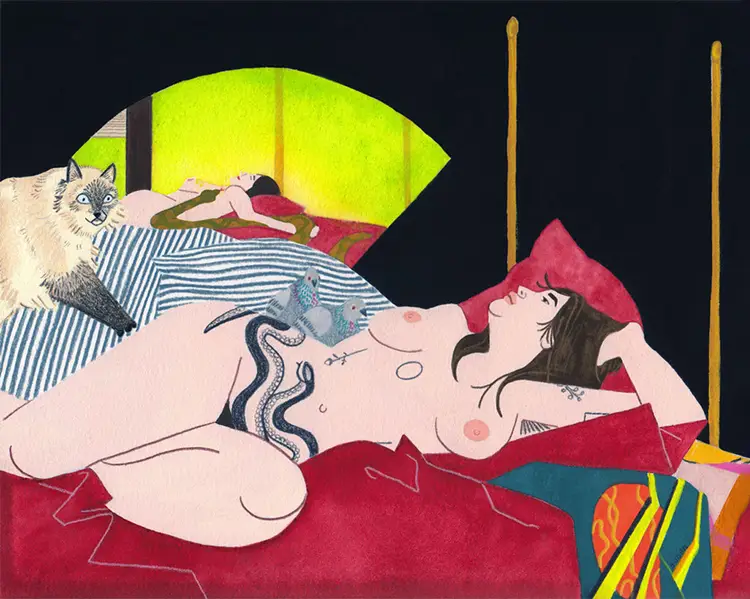
Tools of Intimacy: Materials and Method in Motion
Kelly Bjork’s studio setup reflects the simplicity and intentionality of their art. Their ideal workspace contains little more than a sturdy table, a comfortable chair, and a trusted pencil. They are, by their own admission, highly distractible—something they combat with locked doors and noise-canceling headphones when deep focus is needed. This stripped-down environment helps them maintain clarity, directing their full attention toward the intimacy of mark-making. There’s something deeply resonant about this practice: by minimizing excess, they maximize emotional presence in their work. Each line they draw feels imbued with mindfulness and restraint, echoing their personal commitment to honesty in both life and art.
Their journey with medium is rooted in both discovery and fidelity. Although they initially trained in traditional drawing, a set of gouache paints gifted by their college instructor sparked a lasting love affair. The dense, opaque quality of gouache complements their visual style, allowing them to achieve flat color fields and subtle gradients without sacrificing the immediacy of gesture. Yet even with this shift in medium, their first love remains graphite—a tool they return to time and again for its ability to communicate texture, tone, and emotion without distraction. While they continue to explore new materials, they do so with a sense of grounded loyalty to the tactile processes that first shaped their voice.
Despite their strong connection to paper and brush, Bjork’s creative vision is expanding beyond the studio. They dream of painting large-scale murals throughout Seattle—a desire driven less by ambition and more by a deep yearning to give back to the city that nurtures them. These public works would allow them to bring the warmth and intimacy of their smaller-scale pieces into shared spaces, encouraging spontaneous connections between strangers. For Bjork, mural-making represents not just a new artistic challenge, but a form of communion—an opportunity to bridge the personal and collective through acts of visual generosity.
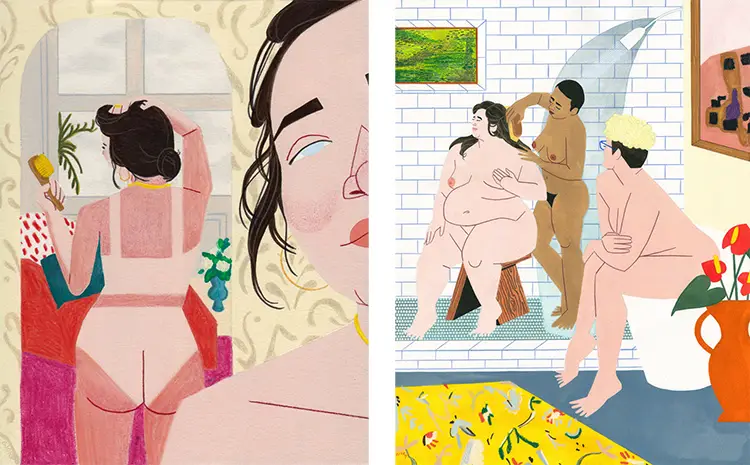
Kelly Bjork: Painting Connection, Holding Space
For Kelly Bjork, art is never just a solitary act—it is a conversation, a shared breath, a way of reaching toward others in a world often defined by separation. Their influences—ranging from David Hockney’s bold emotional clarity to Kerry James Marshall’s narratives of Black life, and from the emotional resonance of Susan Valadon to the stylized elegance of Tsuguharu Foujita—are less about mimicry and more about lineage. These artists, each in their own way, infused figuration with vitality and meaning, and Bjork carries that tradition forward, infusing their work with personal memory, queer visibility, and a profound respect for the human experience.
Their subjects are often people they know—friends, lovers, companions—drawn into domestic spaces where vulnerability isn’t just permitted but celebrated. In this way, their work becomes an archive of lived moments, a record of relationships that anchor their life. They offer viewers glimpses into these private worlds not to create distance, but to encourage recognition. We may not know the people in their paintings, but we recognize the gestures: a brush through wet hair, a quiet gaze, a moment shared without words. These are the acts that shape our days, and Bjork captures them with reverence.
Ultimately, Kelly Bjork’s art serves as both reflection and refuge. They aren’t interested in spectacle or abstraction for its own sake; instead, they commit themself to documenting the emotional intricacies of queer life with tenderness and precision. Their work asks us to slow down, to notice the softness between moments, and to honor the ways we hold each other. Whether in graphite on paper or gouache on a wall, their images resonate not just for what they show, but for how they make us feel—seen, safe, and understood.
